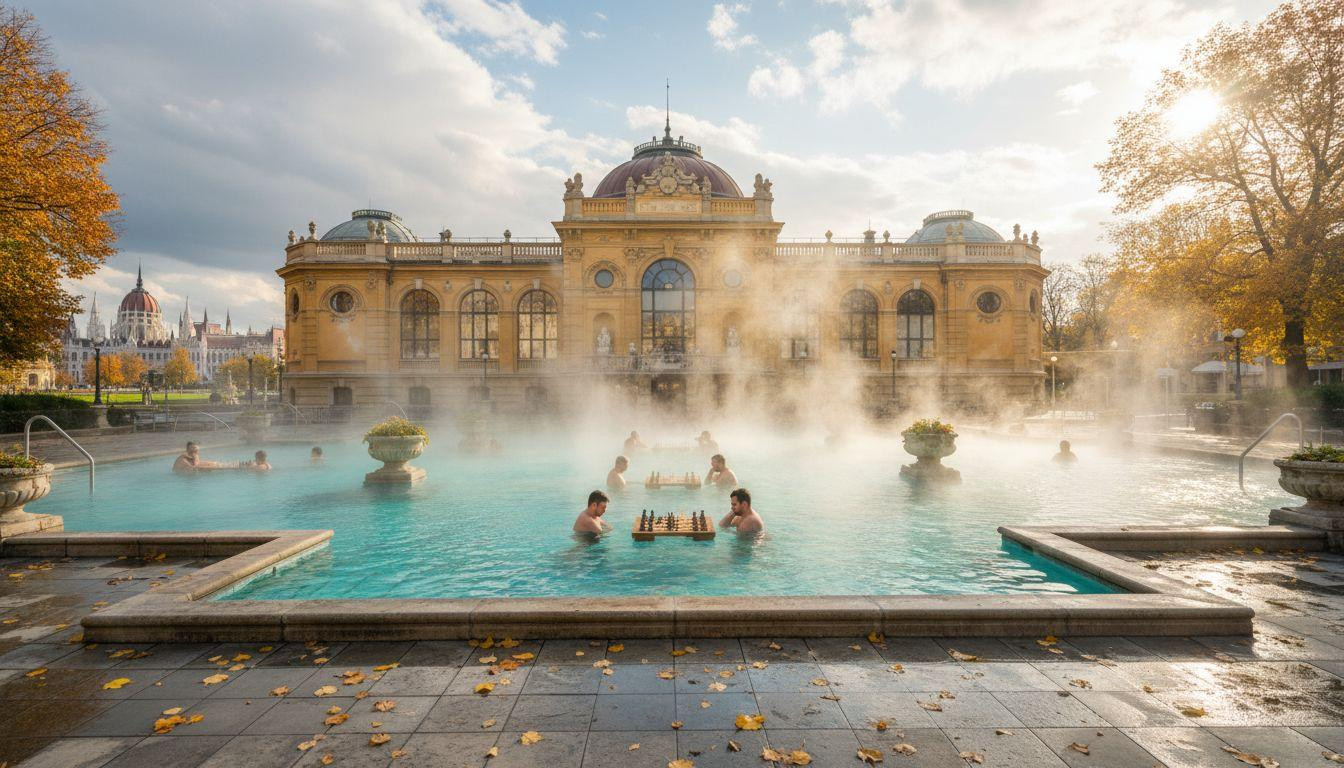November 2025 presents a travel paradox: autumn’s golden light illuminates destinations at their most beautiful, yet seasonal price spikes remain surprisingly absent. While traditional hotspots demand premium rates for peak foliage and harvest celebrations, eight remarkable destinations maintain stable pricing throughout their most spectacular months. These places offer authentic cultural immersion, stunning seasonal beauty, and exceptional value for travelers seeking meaningful experiences without financial strain.
Budapest’s thermal sanctuary defies European pricing trends
Steam rises from 18 outdoor pools at Széchenyi Thermal Bath, creating ethereal clouds in November’s crisp air. Weekday admission costs just $32, while weekends reach $36 with locker included. The contrast with other European capitals is striking.
Locals play chess on floating boards between the 79°F and 104°F pools. Hungarian conversations mix with international chatter as autumn leaves drift across the mineral-rich water. The atmosphere deliberately resists hurry.
Metro day passes cost $5.15, making exploration remarkably affordable. Accommodations in Pest’s center range from $85-140 nightly during November. A full thermal experience including 45-minute massage totals approximately $75, compared to $220 at comparable Nordic spa destinations.
Gothic architecture frames the Danube
Buda Castle’s Neo-Gothic spires reflect in the river at sunset. Parliament’s ornate facades create golden mirrors on calm water. November crowds thin dramatically, allowing genuine appreciation of architectural scale.
Hungarian harvest traditions continue
Lake Balaton wine regions, 90 minutes away, offer Tokaji tastings for $6-10. Traditional goulash costs $8-12 at local establishments. Esterházy torte provides sweet autumn comfort for $4-6.
Mexico City delivers Pre-Hispanic grandeur at fraction of European costs
Seventeen major museums offer free Sunday admission, including the National Anthropology Museum. Metro rides cost 35 cents flat rate. Daily cultural immersion averages just $15-25 total.
Teotihuacan’s ancient pyramids rise 30 miles northeast of the capital. Entrance fees reach only $5.20, with optional guides available for $17.40. The contrast with European archaeological sites is remarkable.
Roma and Condesa neighborhoods house travelers for $75-125 nightly. Street food breakfasts cost $2-4. Traditional almuerzo lunches run $5-8. This represents 40% savings compared to Los Angeles cultural experiences.
Mercado sensory immersion
Vendors arrange lime-green tomatillos in perfect pyramids. Wood smoke rises from grilling stations. Spanish voices negotiate prices in rapid exchanges. The earth scent mixes with fresh cilantro and corn tortillas.
Revolutionary November celebrations
Day of the Dead decorations persist through November 18’s Revolution Day festivities. Street art covers La Roma walls with political murals and abstract pieces. Palacio de Bellas Artes charges just $5 for Diego Rivera masterworks.
Georgian wine country offers harvest experiences at minimal cost
Qvevri clay vessels buried in cellars ferment wine using 8,000-year-old methods. Kakheti region lies 68 miles east of Tbilisi. Marshrutka minibuses cost $3.60 each way.
Family-run supra feasts include multiple wine courses for $29-43 per person. Traditional toasts punctuate every dish. Georgian hospitality traditions make refusing food offers deeply insulting.
Accommodation in Tbilisi’s Old Town ranges $45-85 nightly. Khachapuri cheese bread costs $2.90-5.40. Khinkali dumplings run $4.30-6.50 for six pieces. A complete Georgian wine experience totals $75-100, compared to $220-300 for similar Napa Valley tastings.
Caucasus mountain backdrop
Peaks reaching 16,000 feet form Georgia’s northern border. Alpine hiking trails wind past glacial lakes through evergreen forests. Transportation costs remain minimal beyond basic bus fares.
Tbilisi’s architectural fusion
Ottoman, Persian, and Soviet influences blend unexpectedly. Natural hot springs feed thermal baths in the Old Town. Fifth-century Metekhi Church overlooks the Mtkvari River. Narikala Fortress dominates the skyline after 1,500 years.
Lisbon’s November light creates photographic magic
Autumn accommodation drops 45-50% from summer peaks. November averages $85-140 nightly compared to $160-280 during July-August. Tram 28 rides cost $3.55. Twenty-four hour transport passes reach $7.30.
Alfama’s labyrinthine alleys wind upward through centuries-old buildings. Fading yellows, blues, and pinks create three-dimensional mazes. Each turn reveals unexpected fountains and terracotta rooftop views.
Fourteen free miradouros provide exceptional sunset viewing. Pastéis de Belém custard tarts cost $1.80 each. Traditional sardines run $6-10 grilled whole. Quality Douro wine bottles cost $5-10 in shops, representing exceptional value compared to Barcelona’s $95-130 daily budgets for similar experiences.
Your Questions About Cheap Alternatives to Expensive Hotspots,Top 8 Autumn Destinations That Don’t Spike in Price Answered
Which destinations offer the best value for cultural experiences?
Guatemala and Mexico City provide exceptional archaeological access and indigenous culture for $60-90 daily budgets. Budapest combines thermal wellness with architectural grandeur for $70-95 daily. Georgia offers wine heritage and mountain landscapes for $55-75 daily costs.
How do November weather conditions affect travel plans?
Most destinations experience comfortable temperatures: Mexico City 46-72°F with five rainy days, Lisbon 54-64°F with eleven rainy days, Florence 43-59°F with ten rainy days. Reykjavík offers 18 hours of darkness ideal for Northern Lights viewing despite 30-39°F temperatures.
What makes these destinations immune to seasonal price increases?
Geographic positioning and tourism patterns create pricing stability. Eastern European destinations like Budapest and Georgia maintain low base costs. Latin American locations experience shoulder seasons during Northern Hemisphere autumn. Iceland and Portugal see reduced demand after summer peaks, creating competitive pricing.
Morning fog lifts from the Danube as thermal waters steam in Budapest’s November air. Chess pieces click on floating boards while autumn leaves drift across mineral pools. Eight destinations prove that peak experiences need not require peak pricing. The season’s golden light illuminates authentic cultural treasures waiting for discovery.
